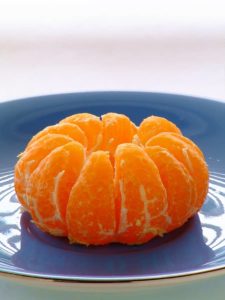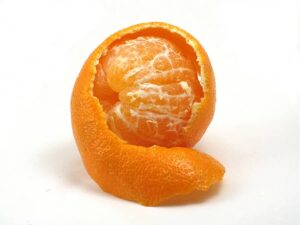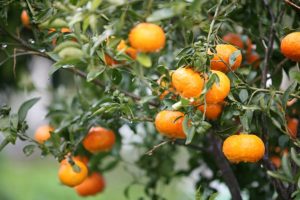Mandarin oranges are mostly small, easy to peel, and perfect for snacking out of hand. You can choose a mandarin for a sweet treat or a mandarin for a sweet-tart treat.

Mandarins can be sectioned and added to fruit, green, chicken or seafood salads. They can be juiced to flavor sorbets, marinades, and dessert sauces, or zested to flavor cakes, muffins, stuffing, and rice dishes.
Mandarins have thin, loose skins with only delicate strands of pith attached to their flesh. They are sometimes called “slip-skin oranges” or “kid gloves” fruit. Once peeled the mandarin’s segments separate easily in the fashion of the petals of a flower.
Mandarin oranges are smaller than oranges and less acidic. They are perfect for eating out of hand or for cooking.
There are more than 200 varieties of mandarins. The most popular are the sweet Satsuma, the smooth juicy Clementines, and the spicy red-orange Dancy. Mandarin cultivars–crosses with sweet oranges or grapefruits–include tart Temple tangor and the honey-flavored Minneola tangelo.
Ways to serve mandarins
Mandarins are best eaten out of hand.
- Use mandarins in light sauces for poultry, fish, and pork.
- Add segments to fruit, green, or rice salads.
- Add sections to sweet-and-sour dishes.
- Use sections to decorate cakes, puddings, and pies.
- Use peel to flavor cakes, muffins, and quick breads.
- Use peel to flavor stews and stir-fries.
Cooking mandarins
Sectioned mandarins can be baked, poached, and sautéed. To preserve their delicate flavor, add mandarins at the end of cooking and just heat through.
- Baking. Peel and section fruit. Glaze and bake until hot (as little as 5 minutes depending on the size of the fruit).
- Poaching. Peel and then simmer in poaching liquid until hot.
- Sautéing. Peel and section. Sauté until hot (less than 3 minutes).
Mandarin harvest time
Depending upon the variety and location, mandarins come to harvest from early winter into summer.

How to choose mandarins
Select mandarins that are deeply colored, free of dull spots, and heavy for their size. Avoid mandarins that are overly bumpy or puffy. They can be old or overripe.
How to store mandarins
Mandarins will keep at room temperature for up to 1 week. They will keep in a plastic bag in the refrigerator for up to 1 month.
How to prepare mandarins
Mandarins are easily peeled with the fingers. They are also easily segmented.
Mandarin flavor partners
Mandarins have a flavor affinity for apricot, banana, chicken, chocolate, crab, cream, duck, fish, hollandaise sauce, melon, passion fruit, scallops, shrimp, sugar, turkey, and vinaigrette.
Mandarin nutrition
Mandarins are a good source of vitamin C.
Mandarins and tangerines
Mandarins make up the largest and most varied group of edible citrus. They are usually less acidic and smaller than oranges with a slightly flattened shape. Their skins can vary in color from greenish gold to deep orange-red. They can be seedless or full of seeds, and they can be sweet tasting or tart.
The mandarin’s ability to cross easily with other citrus and adapt to a wide range of climates has had a large influence on the variety of mandarins and their variations in size, color, and flavor.
It can take a scorecard to keep track of mandarin orange varieties. Perhaps the first task is to make the distinction between the mandarin orange and the tangerine. The terms “mandarin orange” and “tangerine” are often used interchangeably. Here is the difference: a tangerine is a mandarin orange but not all mandarin oranges are tangerines.
Mandarins
There are more than 200 mandarin orange varieties and cultivars. Mandarins have been cultivated and selected for so long–by both man and nature, in so many different parts of the world, that the original forms are lost. That can make classifying mandarins difficult.
Mandarins are sometimes broken into three classifications—mandarin, tangerine, and Satsuma orange. Mandarins and tangerines—depending upon the cultivar–belong to one of two separate species, one called the common mandarin and the other called the Mediterranean mandarin. The Satsuma mandarin is a separate species, a mutation of the original mandarin orange. Extra large mandarins are often classed into a separate species known as king mandarins.
The name Mandarin is taken from the title of counselors in the Chinese imperial courts who wore bright orange robes and headpieces with buttons that resemble fruit.
The citrus called tangerines in Great Britain are mandarins from the Mediterranean region that are pale colored and mild in flavor.
Tangerine
The word tangerine was coined in the United States to name mandarin oranges with very deep orange-red skins. In other parts of the world, the same deeply colored fruits continue to be called mandarins. These deep-colored mandarins were first imported to Florida in the nineteenth century from Tangier, the port in Morocco. They quickly took the name “tangerine”.

Clementine
The clementine has thin, smooth, bright red-orange skin that is very easy to peel and delicate, red-orange flesh that is virtually seedless.
Here’s something to keep in mind about the clementine: the smaller the fruit the more intense the flavor.
Clementines—which are also called Algerian tangerines–are thought to be a natural hybrid between a common mandarin orange and the bitter orange.
The peak season for clementines is early to mid-winter.
Select clementines that feel heavy for their size. They will be juicier. A clementine should be firm to the touch but have some give. The smaller the fruit the more intense the flavor.
Eat clementines out of hand. Use them to garnish poultry and seafood. Include clementines in gelatin desserts, puddings, custards, and fruit cups.
The clementine is named after Father Clément Rodier who discovered this accidental hybrid in the garden of the orphanage he ran near Oran in Algeria in 1900. It is possible that this small citrus came to Algeria from China, but no one knows. The Clementine is mostly grown in North Africa, Spain, California, Arizona, and Texas.
A clementine is a mandarin orange. The botanical name for the mandarin orange is Citrus reticulata.
Related articles:
How to Grow Mandarin Orange – Tangerine
Planning the Home Fruit Garden
Garden Planning Books at Amazon:
- Vegetable Garden Almanac & Planner
- Kitchen Garden Grower’s Guide Vegetable Encyclopedia
- Vegetable Garden Grower’s Guide
- Tomato Grower’s Answer Book
More kitchen tips:
Bring your harvest to the table. Kitchen prep tips and easy recipes for the vegetables you grow. Click below for vegetable prep and recipes you can use now.
- Almonds
- Apples
- Apricot
- Aprium
- Artichoke
- Arugula
- Asparagus
- Avocado
- Bamboo Shoots
- Banana
- Basil
- Beans, Dried
- Beans. Long
- Beans, Shell
- Beans, Snap
- Beets
- Bitter Melon
- Blackberry
- Bok Choy
- Broccoli
- Broccoli Raab
- Brussels Sprouts
- Cabbage
- Cardoon
- Carrots
- Cauliflower
- Celeriac
- Celery
- Chard
- Chayote Squash
- Cherimoya
- Cherries
- Chestnut
- Chickpea
- Chinese Cabbage
- Chives
- Cilantro
- Citron
- Clementine
- Collards
- Coriander
- Corn, Sweet
- Corn, Baby
- Corn Salad, Mache
- Cranberry
- Cress
- Cucumber
- Daikon
- Dandelion
- Dill
- Eggplant
- Endive, Belgian
- Endive and Escarole
- Fava Beans
- Fig
- Florence Fennel
- Garlic
- Ginger
- Grapefruit
- Grapes
- Guava
- Horseradish
- Jerusalem Artichoke
- Jicama
- Jujube
- Kale
- Kiwifruit
- Kohlrabi
- Kumquat
- Leeks
- Lemongrass
- Lemons
- Lettuce
- Lime
- Mache (Corn Salad)
- Mandarin Orange
- Mango
- Maple Syrup
- Marjoram
- Melons
- Michihili
- Mint
- Mizuna
- Mushrooms
- Mushrooms, Cremini
- Mustard Greens
- Napa Cabbage
- Nectarine
- Okra
- Olives
- Olive oil
- Onions
- Oranges
- Oregano
- Parsley
- Parsley Root
- Parsnips
- Passion Fruit
- Pawpaw
- Peaches
- Pears
- Peas, Garden Snap
- Peas, Snow
- Pei Tsai
- Peppers, Chili
- Peppers, Sweet
- Persimmon
- Pineapple
- Pineapple Guava
- Plantain
- Plums
- Pluots
- Pomegranate
- Potatoes
- Prickly Pear
- Pumpkin
- Quince
- Radicchio
- Radishes
- Raspberries
- Rosemary
- Rhubarb
- Rutabaga
- Sage
- Salsify
- Sauerkraut
- Savory
- Shallots
- Sorrel
- Spinach
- Squash, Summer
- Squash, Winter
- Strawberries
- Sunchokes
- Sunflower
- Sweet Potato
- Swiss Chard
- Tangerine
- Taro
- Tarragon
- Thyme
- Tomatillo
- Tomato
- Turnip
- Turnip Greens
- Yams



